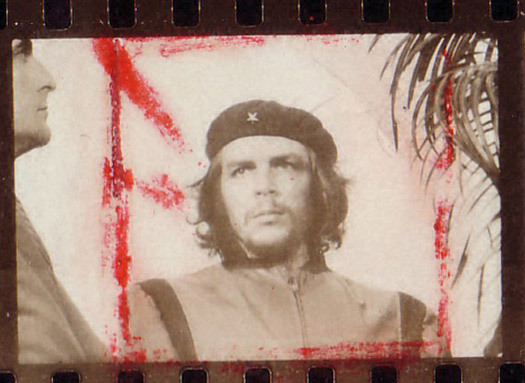
Contact print by Korda, 1960 (© ADAGP, Paris / Scala, Florence / DACS, London)
The world's best-known portrait is not a painting, nor a photograph, but a work of graphic design — yet most designers are unaware of the origins of this world-famous image.
Walk through any of the world’s major cities and it is likely you will catch, at least, a glimpse somewhere of the iconic portrait of Dr. Ernesto ‘Che’ Guevara (1928-1967). Whether printed on a passing T-shirt, stencilled on a brick wall, or parodied on the cover of a magazine or poster, Guevara’s concentrated, far-away gaze stares out with a force of recognition that is almost unique in the history of portraiture.
Today, the portrait can fairly claim to be better known than any other picture of a face. Its status is such that it has a currency in nearly every corner of the world, and this in spite of the inevitable and gradual decline in significance of this Argentinian-born Marxist revolutionary since his heyday in the late 1960s.
Even the world’s most popular religion, Christianity, with a history of portraiture that stretches back to the first centuries of the common era, has not produced anything so familiar to so many. Which portrait of Christ is widely known? If there really is a rival to Guevara’s portrait, it is more likely to come from the secular side of art. The Mona Lisa is an obvious contender and maybe now the giant head of Mao Zedong, which hangs over the main entrance to Tiananmen Square in Beijing, is another.
Why it is, though, that this rendition of this particular head should have acquired its logo-like status cannot be explained by any single fact or reason. The success of the portrait has relied on a host of influences, some of which are historical and have little to do with the image per se: the longevity of Guevara's comrade-in-arms, Fidel Castro, as Cuba’s leader, or the periodic vogue for countercultural styles of design, say, or perhaps even the intervening periods of anti-Americanism.
Other influences relate to the image very directly. As important as any of these are the ones that relate to the semantics of the image: what the particular portrait meant to people when it first appeared, and then how its meaning has changed over time.
The fact that the image has absorbed multiple meanings has been essential to its success. For those who knew Che Guevara the man, or the myth of him at least, the portrait has been able to stand both as a particular representation of him, and then also as a general representation of “the guerrilla”, and, more broadly still, a general symbol of rebellion. Today, it is these more general meanings that predominate, since most people who know the portrait could neither say whom it depicts nor why he is celebrated.
Che, the Man
Che Guevara first launched himself onto the world stage during the late 1950s, after helping Fidel Castro overthrow a corrupt and unpopular Cuban dictatorship with only a small guerrilla force. Though the size of the insurrection was modest, certainly when compared to some of the other guerrilla rebellions of the time, it received widespread international attention.
The victory of this small band of social revolutionaries was welcomed not only by most Cubans, but also by many from beyond the shores of this Caribbean island, especially those on the left of the political spectrum in the West, who, having endured a decade of conservatism in their own countries, could hardly have imagined a more glamorous or inspirational political coup.
All were seduced by the leaders of the new Cuban government. For one, they were astonishingly young. Few of them, including the principal figures of Castro and Guevara, were much over 30 years old. But, also, many of them were ex-students, principled young men from the middle classes, who had chosen to reject the privilege and ease that their upbringing had brought them in order to help improve the lives of the poor and the oppressed. Guevara, himself a medical graduate from Buenos Aires University and from a wealthy upper-class family, seemed to speak for his comrades when he described himself as “one who risks his skin to prove his truths.”
Of all the various leaders of “third-world” guerrilla groups from the 1950s and 1960s, Guevara was especially venerated. It helped that he regularly supplemented his deeds with words. As well as writing several books on the art of guerrilla warfare, he also published his own diaries, which described his travels within and beyond South America, and thereby gave greater definition to the varied impressions then being sketched of him by the international press.
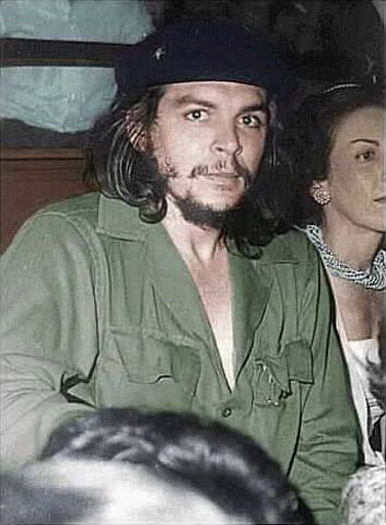
Che Guevara in his trademark olive-green military fatigues, June 2, 1959 Cuba. Photo Credit: Museo Che Guevara
As well as being young, brave and articulate, Guevara was also photogenic, or, as some accounts had it, positively beautiful. The rugged features captured on camera succeeded in fluttering the hearts of even the most non-political observers.
A more sombre but nonetheless powerful influence on his public persona was the manner and timing of his death. While leading another guerrilla-style insurrection, this time in the South American country of Bolivia, Guevara was captured, held prisoner and executed. By paying the ultimate price for proving his truths at the relatively young age of 39, Guevara’s persona became imbued with a macabre form of glamour twice over: that accorded to the martyr and that of the young dead.
Che, the Image
All these facets of Guevara’s life and character made him, in the era of a picture-based mass media, an ideal candidate for the role of the Left’s poster boy; if, that is, one can accept, as his many admirers seemed to (peace-loving hippies included), the essentially violent manner in which he prosecuted his political aims.
In spite of his many murderous actions, however, his attractive qualities remained. For a graphic image to dominate in quite the way it did, it had to encapsulate or, at least, suggest these more positive qualities and clearly, this particular portrait did so successfully. But it also did so variously.
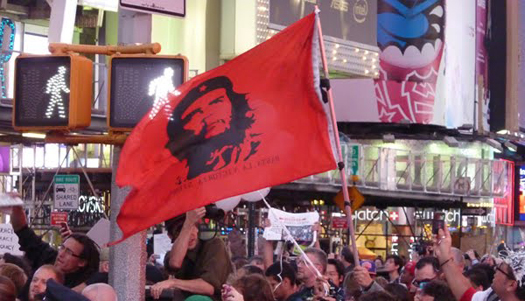
Che Guevara in New York City, Occupy Times Square, 2011. Photo Credit: The Cahokian
As well as symbolizing Guevara’s compelling history, his long hair and beard, which was emblematic of the guerilla the world over, also aligned him with contemporary youth fashions inside and outside Cuba, while at the same time setting him against the clean-cut look of the American establishment. His beret, not the peaked cap one might expect of a military leader, aligned him with the common man. Its star denoted his high rank and signalled the socialist orientation of his revolutionary aims. Other positive associations linked to the symbol (a celestial object, a divine signal, a light shining out of the darkness) and to the word “star” (a celebrity, a person of great ability) also accrued.
Just as important as these associative qualities was the very practical quality of the image’s reproducibility. The flat, ink-blot-like shapes that made up the portrait’s features could be sprayed through a stencil onto a wall, or squeezed through the gauze of a silk-screen, without any loss of emotional intensity or symbolic power. They contributed greatly to the wide take-up of the image and its appearance on almost any material capable of holding its painted or printed form. It was this that contributed to its paradoxical position of being both enormously popular yet not identified with any particular object or, even, any exact version of itself.
Che, the Photograph
This defining aspect of the image, its mutable graphic simplicity, had not always been a feature of the portrait. The origins of the image actually lay in a photograph, taken in 1960 by a Cuban photographer, Alberto Díaz Gutiérrez, or Korda as he was known professionally.
Korda had been asked by a newspaper to cover a mass funeral which was to take place the day after a violent explosion had ripped through the side of a munitions ship moored in the harbour of Cuba’s capital, Havana. The blast had succeeded in killing more than 80 people. Castro, who was goaded by the belief that an American invasion was not just inevitable but imminent, blamed the CIA, and said as much during a lengthy funeral address delivered to a vast crowd gathered in Havana’s central Revolution Square. Though the sombre ranks of mourners had come to honour the dead, Castro's words excited in them a latent sense of indignation and solidarity that grew and spread until all were transformed into the kind of passionately partisan throng more usually associated with a mass rally. The funereal tone had mutated into a spontaneous expression of national unity. It was within this highly charged atmosphere, during a part of Castro’s speech, that Korda “panned the podium and suddenly Che moved forward into my camera. I made a picture, and immediately thinking of a cover for our newspaper, turned the camera vertical, made another — and the moment had gone.”
In the all-important first, horizontal picture, Korda captured an almost messianic intensity in Guevara’s expression. It appeared to stem from some inner conflict; from an impassioned commitment yet, also, an ethereal sense of detachment. The set of his eyes, staring out over the sea of mourners into the middle distance, the resolute cast of his other facial features, the upward tilt of the head and the slightly opposing slant of his beret, all combined to give the impression that in that very moment, within the sliding click of the camera’s shutter frame, Guevara had determined to avenge the indiscriminate loss of life and redouble his efforts in furthering the spread of his revolutionary brand of Marxism.
The eloquence of his expression was also informed by some important formal properties. The photograph’s angle of view, being from below, exposed the whites of his eyes which in turn helped to define the dark intensity of his gaze, while the auspicious fall of shadow that surrounded his face emphasized his bone structure beautifully. Both properties contributed to the power of the subsequent ink-blot image.
For all its strengths as a portrait, the newspaper that had commissioned Korda didn’t use the picture. In fairness, it was only when Korda returned to the studio and cropped the picture tightly around the head (indicated by the red crayon mark on the contact print above), focusing on the intensity of Guevara’s expression, that its true power became apparent. Subsequent prints of this cropped version, which Korda gave out to various visitors, soon found their way into some early posters and other kinds of printed material, but even then the image had to wait until Guevara’s death in 1967 before achieving its iconic status.
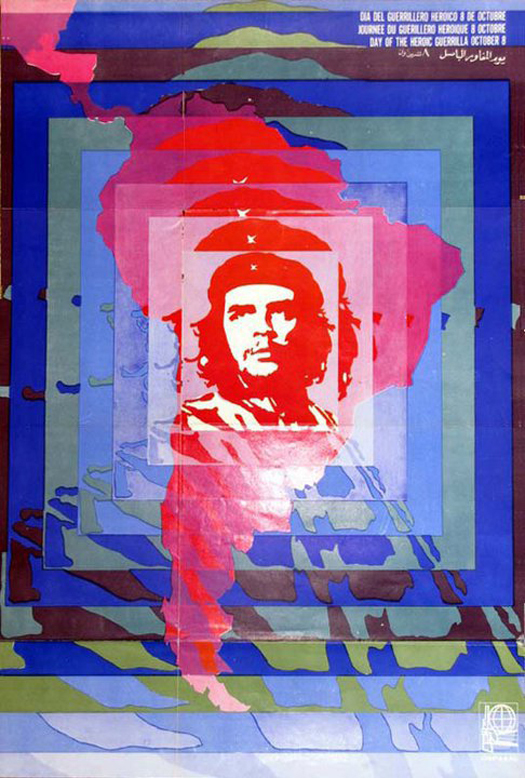
Day of the Heroic Guerrilla 8th October by Elena Serrano, 1968 (© gift of OSPAAAL, Museum of Modern Art, New York / Scala, Florence)
Che, the Icon
One of the posters made in direct response to his passing was the official commemorative poster produced on the first anniversary of his death. The Day of the Heroic Guerrilla, on 8th October, a date still honoured in Cuba. The poster’s Cuban designer, Elena Serrano, centred Guevara’s portrait on the country of Bolivia, at the heart of South America, where Guevara had died, and then had his image radiate out across the whole continent and beyond.
The international emphasis of the poster’s message reflected the international nature of the socialist ideology that had guided Cuban poster design during the first decades of the revolution. The name of the government agency that had commissioned the poster, OSPAAAL (the Organization in Solidarity with the People of Asia, Africa and Latin America), made this global emphasis explicit, as indeed did the poster’s title by being printed in four languages: Spanish, French, English and Arabic. By limiting the amount of text on the poster to the title only — in other words, by relying on an image to carry the core message — Serrano made sure that the international appeal of the poster would not be hindered by any language barrier.
A similar awareness of the poster’s international audience lay behind the style of its design which, like other Cuban posters of the time, contained the kind of vibrant colours and strong Op Art contrasts that had made the psychedelic posters of its continental neighbour popular.
By the late 1960s, the portrait of Guevara had spread outside Latin America. It had been adopted by anti-Vietnam War protesters in the United States who, by adhering to the logic of the ancient political maxim ‘the enemy of my enemy is my friend’, expressed support not only for the guerrilla leader they were being asked to fight, Ho-Chi-Minh (“Ho Ho Ho-Chi-Minh” was the popular chant), but for other guerilla leaders too. Placards showing Guevara’s portrait were held aloft by anti-war protesters inside and outside the United States. For student demonstrators in Paris, Prague and Tokyo, Guevara was as much an icon of rebellion as a symbol of protest against the Vietnam War.
The left-wing orientation of many of these groups chimed with Korda’s own political sympathies. It was because he was so keen to see Guevara’s socialist message spread that Korda refused to accept payment for the use of his photograph. Such a principled stance certainly contributed to the image’s popularity, but, in so doing, it established a paradox. By rejecting the capitalistic notion of intellectual property Korda opened the way for others to exploit the commercial potential of his image, especially after the idea of ‘the guerrilla’ had become established as a romantic symbol of rebellion (due in no small part to the effectiveness of his own photograph).
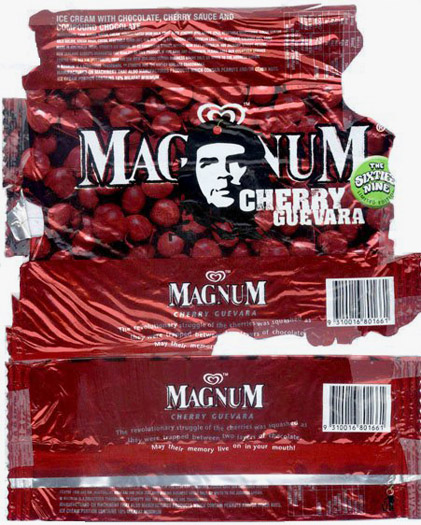
Magnum Cherry Guevara ice-cream wrapper, 1990s, Australia (© David Kunzle, The Centre for the Study of Political Graphics and Trisha Ziff)
Quite unintentionally then, what had begun as an inspiration for a whole generation of socialists was in time transformed into a marketing tool for some of capitalism’s most quintessential goods: cigarettes, bikinis, cars, ice cream and the like. In this way it seemed that the more Guevara’s image spread, the further it strayed from the man. Or as one commentator described the process more generally, “Capitalism devours everything … even its worst enemies.”
This essay has been adapted from the author's recent publication: The Story of Graphic Design (New York: Abrams, and London: The British Library, 2010). Text © Patrick Cramsie, 2011.


Comments [12]
http://www.reuters.com/article/2011/02/17/us-ireland-art-che-idUSTRE71G5UG20110217
11.17.11
05:15
I dislike the crass commercial usage of the image and it is better that the family and the Cuban people look after the usage of the image.
I have never ever licensed this image for any purpose to anyone or any company EVER. I allowed free use for only political purposes but I did intend that it proliferate and keep the name of Che alive after his brutal murder and when his body was 'dissappeared'.
This handover should be completed by mid-2012.
Thank you. Jim FitzPatrick. Dublin, Ireland
PS. Great site. :)
11.17.11
06:02
11.18.11
03:03
11.18.11
10:18
During 1967 and 1968 a number of designers and artists, in various parts of the world, adapted or abstracted Korda's photograph in rather similar ways, and there is no evidence to suggest that these early versions were linked by a single chain of influence. Which is to say that no single design made the transformative leap that all others designers felt they must follow.
It is very likely, also, that different designs would have 'facilitated' a transformation in different parts of the world. For Cubans, the facilitating image may have been the first Che poster that was printed in their country, designed by Frémez (José Gómez Fresquet) for a rally that took place in October 1967, soon after Che's death. Or perhaps it was the first poster to be commissioned by the Cuban state, which appeared during the same month and was designed by another prominent Cuban designer, Niko (Antonio Pérez González).
For a French person, it might have been the poster designed at the end of 1967 by the great Polish designer, Roman Cieslewicz, who had moved to Paris by this time. An American might have seen the image first in February 1968 on Paul Davis' poster or cover design for the magazine Evergreen Review; while during the same year, a Londoner might have had the good fortune of having a Che flier thrust into his or her hand by Jim Fitzpatrick himself.
It should be said, though, that Mr. Fitzpatrick's renditions of Che do appear to have been influential. They are said to have been widely circulated, especially in other parts of Europe and the US. Moreover, most modern examples of the portrait resemble one of Mr. Fitzpatrick's early versions more than they do any of the early versions by any other designer or artist.
I should also say that I share his dislike of the way the portrait has been used commercially. It was partly in an effort to reconnected the image with its origins that I wrote the article above.
11.19.11
01:10
My parents were poor people when the revolution happened and they had even less after. They robbed me of my heritage. Because of him helping Castro, the Cuban people have been oppressed, starved, murdered for years. That is not a hero to me.
11.21.11
04:49
This piece was intolerably long and it's premise flawed. But interesting.
11.21.11
05:37
11.22.11
05:04
11.22.11
07:47
I enjoyed your piece. I was just making clear the current status of the image, which of course I am very proud of.
Strangely enough the VERY first Che poster was, I believe, not my red and black of May 1968 but my own black and white from 1967 (a rush job from a tiny magazine reference that I had to enlarge on a Grant and redraw to try and get the thing right) and another by Martinez and a third in a 'Yellow Submarine' style and beautiful too. Not sure who the artist was, perhaps Martinez again.
www.flickr/photos/jimfitzpatrick > che set on right
http://www.flickr.com/photos/jimfitzpatrick/303436547/in/set-72157594331525657
The three shown on the link are the very first to use the Korda photo as reference. The beautiful Elena Serrano poster was a bit later. My red and Black Che, the famous one, was out in May 1968 later thann these three.
The photo is one I took at the very first Korda/Che exhibition by Trisha Ziff at UCLA in Riverside, LA.
Jim Fitzpatrick
11.23.11
09:30
11.23.11
04:07
Although Guevara's place in history is a matter of - largely political - debate, I don't believe that there is any doubt of that particular image's status as an icon.
One may not agree with his politics, and one may not endorse or condone all of his actions. However, as a Greek living in Athens - a city with a sizable leftist/anarchist contingent and very far away from Latin America - I can attest to the ubiquity of the image as a symbol of class war and self-sacrifice in the name of popular struggle.
In my view, an image/photo becomes an icon when it starts to have a symbolic meaning attributed to it which transcends the specific historical/political/social circumstances under which it was taken/produced. In that sense -although I may not personally agree with all its connotations- I definitely consider Che's portrait to be iconic.
11.24.11
06:40